Main Page: Difference between revisions
| Line 214: | Line 214: | ||
| width="30%" | | | width="30%" | | ||
* [http://en.wikipedia.org/wiki/Scientific_Linux Scientific Linux] | * [http://en.wikipedia.org/wiki/Scientific_Linux Scientific Linux] | ||
* [http://en.wikipedia.org/wiki/Help:Cheatsheet | Help with editing Wiki pages] | |||
|} | |} | ||
Revision as of 11:39, 7 January 2014
The Breed4Food (B4F) cluster is a joint High Performance Compute (HPC) infrastructure of the Animal Breeding and Genomics Centre (WU-Animal Breeding and Genomics and Wageningen Livestock Research) and four major breeding companies: Cobb-Vantress, CRV, Hendrix Genetics, and TOPIGS.
Rationale and Requirements for a new cluster

The B4F Cluster is, in a way, the 7th pillar of the Breed4Food programme. While the other six pillars revolve around specific research themes, the Cluster represents a joint infrastructure. The rationale behind the cluster is to enable the increasing computational needs in the field of genetics and genomics research, by creating a joint facility that will generate benefits of scale, thereby reducing cost. In addition, the joint infrastructure is intended to facilitate cross-organisational knowledge transfer. In that capacity, the B4F Cluster acts as a joint (virtual) laboratory where researchers - academic and applied - can benefit from each other's know how. Lastly, the joint cluster, housed at Wageningen University campus, allows retaining vital and often confidential data sources in a controlled environment, something that cloud services such as Amazon Cloud or others usually can not guarantee.
Process of acquisition and financing
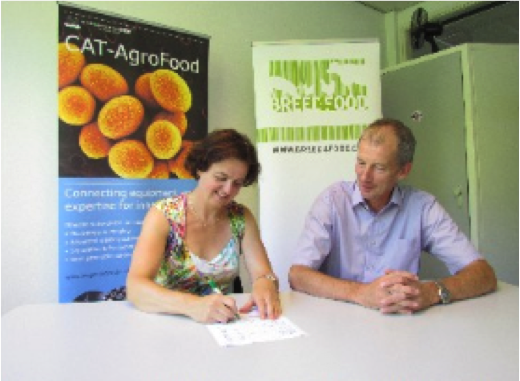
The B4F cluster was financed by CATAgroFood. The IT-Workgroup formulated a set of requirements that in the end were best met by an offer from Dell. ClusterVision was responsible for installing the cluster at the Theia server centre of FB-ICT.
Architecture of the cluster
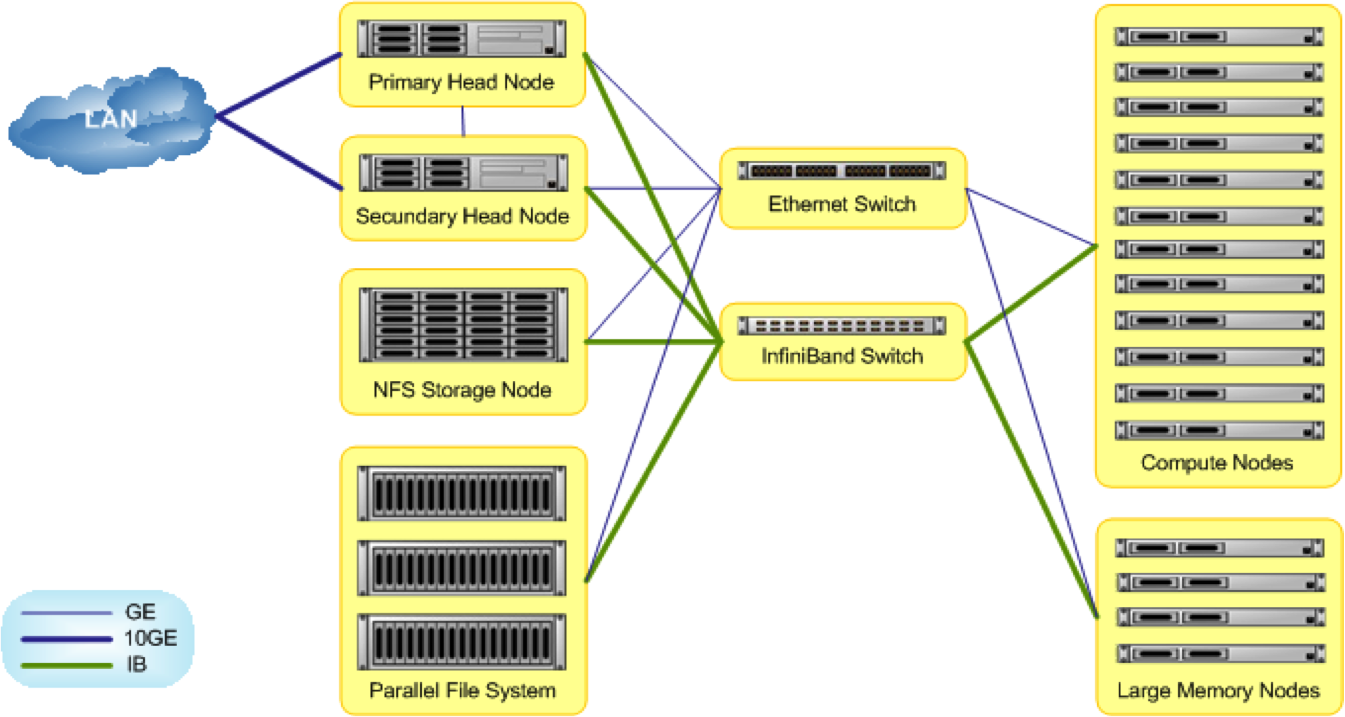
The new B4F HPC has a classic cluster architecture: state of the art Parallel File System (PSF), headnodes, compute nodes (of varying 'size'), all connected by superfast internet connections (Infiniband). Implementation of the cluster will be done in stages. The initial stage includes a 600TB PFS, 48 slim nodes of 16 cores and 64GB RAM each, and 2 fat nodes of 64 cores and 1TB RAM each. The overall architecture, that include two head nodes in fall-over configuration and an infiniband network backbone, can be easily expanded by adding nodes and expanding the PFS. The cluster management software is designed to facilitate a heterogenous and evolving cluster.
Nodes
The cluster consists of a bunch of separate machines that each has its own operating system. The default operating system throughout the cluster is Scientific Linux version 6. Scientific Linux (SL) is based on Red Hat Enterprise Linux (RHEL), which currently is at version 6. SL therefore follows the versioning scheme of RHEL.
The cluster has two master nodes in a redundant configuration, which means that if one crashes, the other will take over seamlessly. Various other nodes exist to support the two main file systems (the Lustre parallel file system and the NFS file system). The actual computations are done on the worker nodes or compute nodes. The cluster is configured in a heterogeneous fashion: it consists of 48 so called 'slim nodes', that each have 16 cores and 64GB of RAM (called 'node001' through 'node060'; note that not all node names map to physical nodes), and two so called 'fat nodes' that each have 64 cores and 1TB of RAM ('fat001' and 'fat002').
Information from the Cluster Management Portal, as it appeared on November 23, 2013:
DEVICE INFORMATION
Hostname State Memory Cores CPU Speed GPU NICs IB Category
master1, master2 UP 67.6 GiB 16 Intel(R) Xeon(R) CPU E5-2660 0+ 2199 MHz 5 1
node001..node042, node049..node054 UP 67.6 GiB 16 Intel(R) Xeon(R) CPU E5-2660 0+ 1200 MHz 3 1 default
node043..node048, node055..node060 DOWN N/A N/A N/A N/A N/A N/A N/A default
mds01, mds02 UP 16.8 GiB 8 Intel(R) Xeon(R) CPU E5-2609 0+ 2400 MHz 5 1 mds
storage01 UP 67.6 GiB 32 Intel(R) Xeon(R) CPU E5-2660 0+ 2200 MHz 5 1 oss
storage02..storage06 UP 67.6 GiB 32 Intel(R) Xeon(R) CPU E5-2660 0+ 2199 MHz 5 1 oss
nfs01 UP 67.6 GiB 8 Intel(R) Xeon(R) CPU E5-2609 0+ 2400 MHz 7 1 login
fat001, fat002 UP 1.0 TiB 64 AMD Opteron(tm) Processor 6376 2299 MHz 5 1 fat
Main cluster node configuration:
- Master nodes: 2 PowerEdge R720 master nodes in a failover configuration
- The NFS server is a PowerEdge R720XD, which will share some applications and databases with machines in the cluster, for which the parallel file system is not the ideal solution. The NFS node will also act as a login node, where users log in and compile applications and submit jobs.
- 50 compute nodes
- 12x Dell PowerEdge C6000 enclosures, each containing four nodes
- 48x Dell PowerEdge C6220; 16 Intel Xeon cores, 64GB RAM each
- 2x Dell R815; 64 AMD Opteron cores, 1TB RAM each
Hyperthreading is disabled in compute nodes.
Filesystems
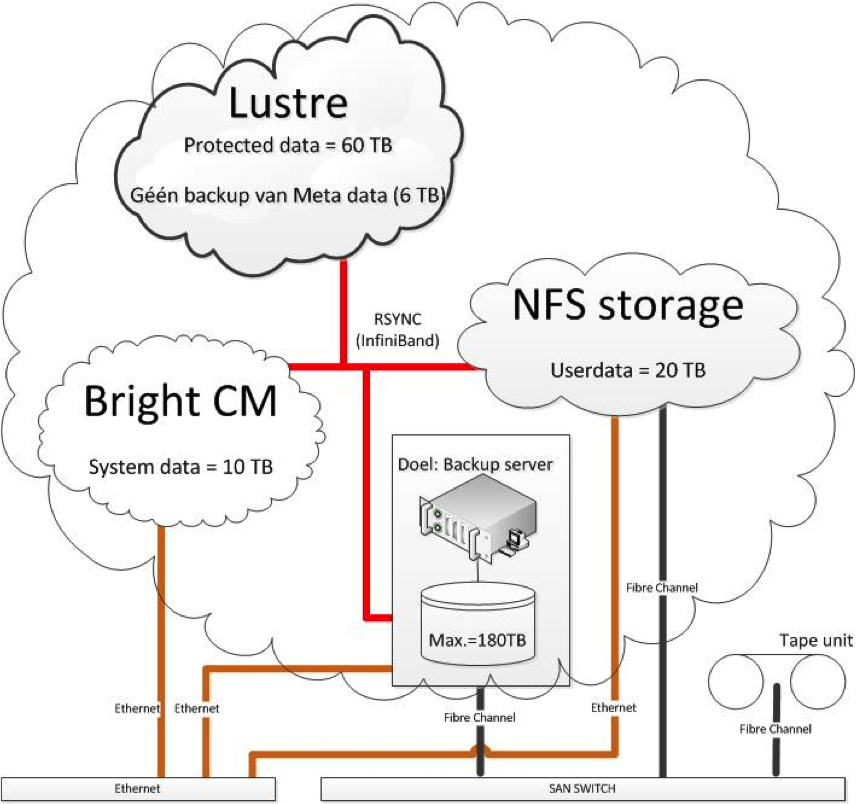
The B4F Cluster has two primary file systems, each with different properties and purposes.
Parallel File System: Lustre
At the base of the cluster is an ultrafast file system, a so called Parallel File System (PFS). The current size of the PFS is around 600TB. The PFS implemented in the B4F Cluster is called Lustre. Lustre has become very popular in recent years due to the fact that it is very feature rich, deemed very stable, and is Open Source. Lustre nowadays is the default option for PFS in Dell clusters as well as clusters sold by other vendors. The PFS is mounted on all head nodes and worker nodes of the cluster, providing a seamless integration between compute and data infrastructure. The strength of a PFS is speed - the total I/O should be up to 15GB/s. by design. With a very large number of compute nodes - and with very high volumes of data - these high read-write speeds that the PSF can provide are necessary. The Lustre filesystem is divided in several partitions, each differing in persistence and backup features. The Lustre PSF is meant to store (shared) data that is likely to be used for analysis in the near future. Personal analysis scripts, software, or additional small data files can be stored in the $HOME directory of each of the users.
The hardware components of the PFS:
- 2x Dell PowerEdge R720
- 1x Dell PowerVault MD3220
- 6x Dell PowerEdge R620
- 6x Dell PowerVault MD3260
Network File System (NFS): $HOME dirs
Each user will have his/her own home directory. The path of the home directory will be:
/home/[name partner]/[username]
/home lives on a so called Network File System, or NFS. The NFS is separate from the PFS and is far more limited in I/O (read/write speeds, latency, etc) than the PFS. This means that it is not meant to store large datavolumes that require high data transfer or small latency. Compared to the Lustre PFS (600TB in size), the size of the NFS is small in comparison - only 20TB. The /home partition will be backed up daily. The amount of space that can be allocated is limited per user. Personal quota and total use per user can be found using:
<source lang='bash'> quota </source>
The NFS is supported through the NFS server that also serves as access point to the cluster.
Hardware components of the NFS:
- 1x Dell PowerEdge R720XD
- 1x Dell PowerVault MD3220
Network
The various components - head-nodes, worker nodes, and most importantly, the Lustre PFS - are all interconnected by an ultra-high speed network connection called InfiniBand. A total of 7 InifiniBand switches are configured in a fat tree configuration.
Housing at Theia
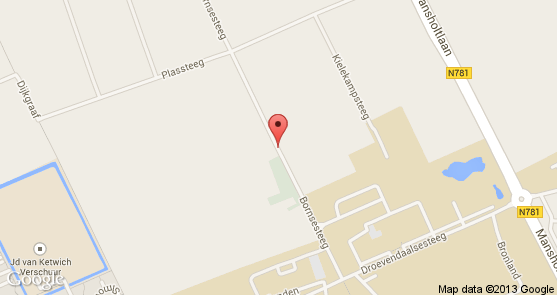
The B4F Cluster is housed at the main server centre of WUR-FB-ICT, near Wageningen Campus. The building (Theia) may not look like much from the outside (used to function as potato storage) but inside is a modern server centre that includes, a.o., emergency power backup systems and automated fire extinguishers. Many of the server facilities provided by FB-ICT that are used on a daily basis by WUR personnel and students are located there, as is the B4F Cluster. Access to Theia is evidently highly restricted and can only be granted in the presence of a representative of FB-ICT.
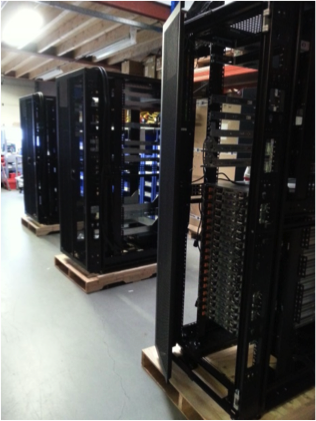 |
 |
Management
Project Leader
- Stephen Janssen (WUR-FB-ICT)
Daily Project Management
- Koen Pollmann (WUR-FB-ICT)
- Andre ten Böhmer (WUR-FB-ICT)
Steering Group
Ensures that the HPC generates enough revenues and meets the needs of the users. This includes setting fees, developing contracts, attracting new users, decisions on investments in the HPC and communication.
- Frido Hamoen (CRV, on behalf of Breed4Food industrial partners, replaced Alfred de Vries in August)
- Petra Caessens (CAT-AgroFood)
- Wojtek Sablik (WUR-FB-ICT)
- Edda Neuteboom (CAT_AgroFood, secretariat)
- Johan van Arendonk (Wageningen UR, chair).
IT Workgroup
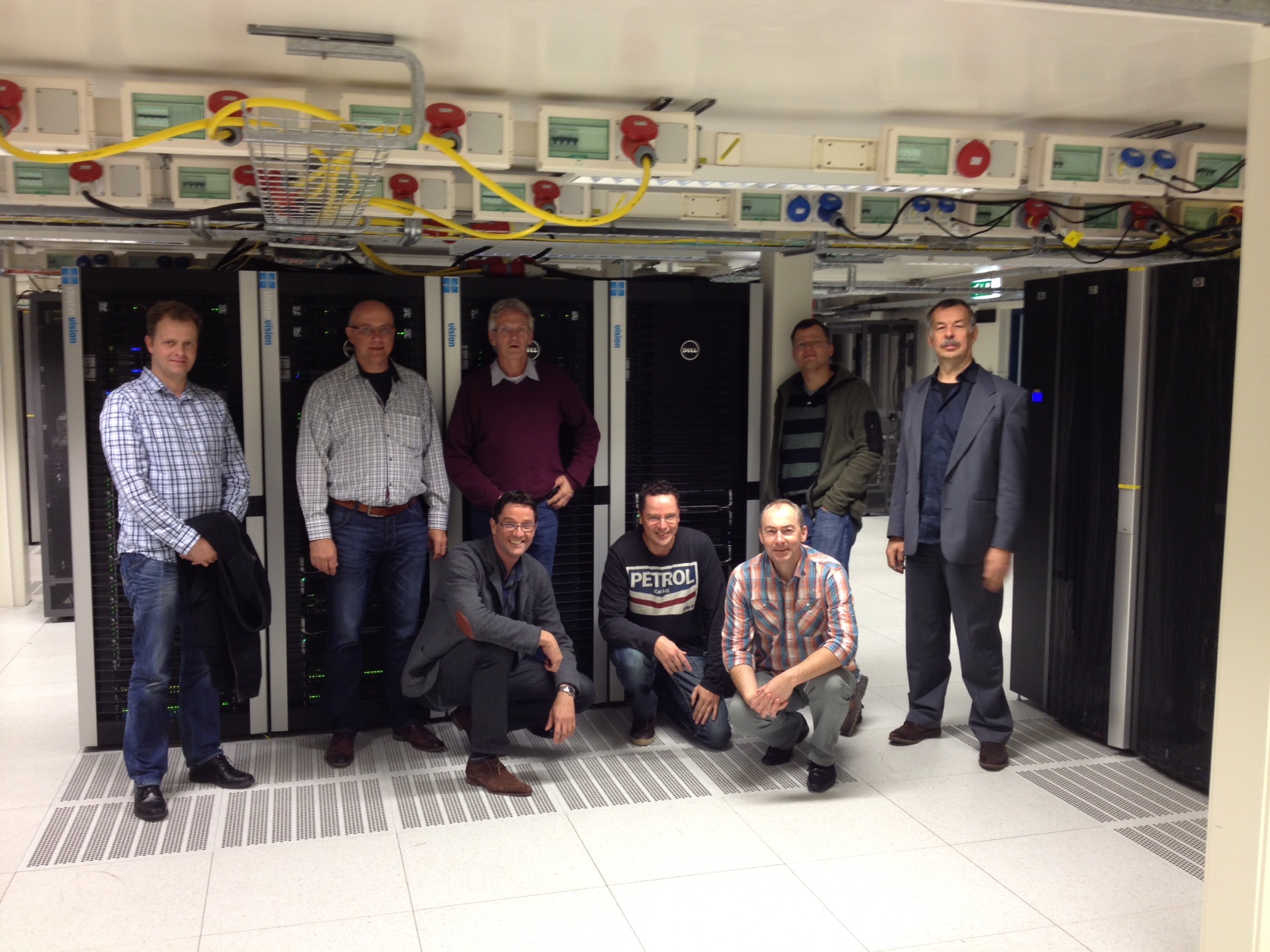
Is responsible for the technical performance of the HPC. The IT-workgroup has been involved in the design of the HPC and the selection of the supplier. They will support the technical management of the HPC and share experiences to ensure that the HPC meets the needs of its users. The IT-workgroup will advise the steering group on investments in software and hardware.
- Stephen Janssen (WUR-FB-IT Service Management)
- Koen Pollmann (WUR-FB-IT Infrastructure)
- Andre ten Böhmer (WUR-FB-IT Infrastructure)
- Wes Barris (Cobb)
- Ton Dings (Hendrix Genetics)
- Henk van Dongen (Topigs)
- Harry Dijkstra (CRV)
- Mario Calus (ABGC-WLR)
- Hendrik-Jan Megens (ABGC-ABG)
User Group
The User Group ultimately is the most important of all groups, because it encompasses the users for which the infrastructure was built. In addition, successful use of the cluster will rely on an active community of users that is willing to share knowledge and best practices, including maintenance and expansion of this Wiki. Regular User Group meetings will be held in the future [frequency to be determined] to facilitate this process.
Access Policy
Access policy is still a work in progress. In principle, all staff and students of the five main partners will have access to the cluster. Access needs to be granted actively (by creation of an account on the cluster by FB-ICT). Use of resources is limited by the scheduler. Depending on availability of queues ('partitions') granted to a user, priority to the system's resources is regulated.
Contact Persons
A request to access the cluster needs to be directed to one of the following persons (please refer to appropriate partner):
Cobb-Vantress
- Wes Barris
- Jun Chen
ABGC
Animal Breeding and Genetics
Wageningen Livestock Research
- Mario Calus
- Ina Hulsegge
CRV
- Frido Hamoen
- Chris Schrooten
Hendrix Genetics
- Ton Dings
- Abe Huisman
- Addie Vereijken
Topigs
- Henk van Dongen
- Egiel Hanenbarg
- Naomi Duijvensteijn
Using the B4F Cluster
Gaining access to the B4F Cluster
Access to the cluster and file transfer are done by ssh-based protocols.
Cluster Management Software and Scheduler
The B4F cluster uses Bright Cluster Manager software for overall cluster management, and Slurm as job scheduler.
Installation of software by users
- Installing domain specific software: installation by users
- Setting local variables
- Installing R packages locally
- Setting up and using a virtual environment for Python3
Installed software
Being in control of Environment parameters
- Using environment modules
- Setting local variables
- Set a custom temporary directory location
- Installing R packages locally
- Setting up and using a virtual environment for Python3
Miscellaneous
See also
External links
|
|